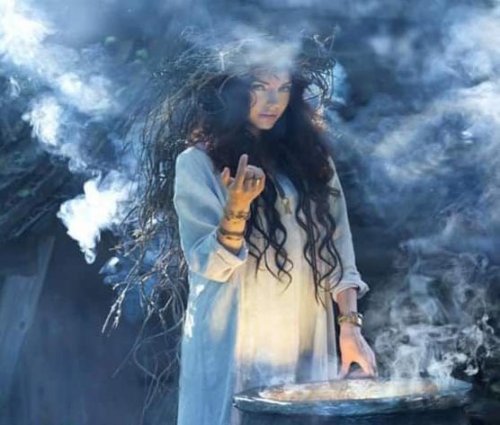
Every woman would like to have magical powers to solve her problems and help her loved ones. Sometimes, this is actually possible for certain women—witches. Supernatural abilities can be passed down through the female line for several generations. The word “witch” means “to know” or “to be aware.” Therefore, a witch is someone who possesses secret knowledge not available to the average person.
The appearance of a witch
While witches were once perceived as negative characters, believed to cast spells, curses, spoil food, or kill pets, the image of witches is no longer entirely negative. While witches were once depicted as hunched, hideous old women with disheveled hair and tattered clothing, today they are often portrayed as young, attractive women with a beautiful figure. In Russian folklore, a witch was an unattractive old woman who could transform into a beautiful young woman. In Ukraine, however, witches were depicted as young and beautiful women, often widows, who lured men's souls into their magical snares. Many also believed that witches had the ability to cause various natural disasters, such as hail, hurricanes, fires, or storms, and could bewitch people or turn them to stone.
A witch is indistinguishable from an ordinary woman by her outward appearance, although they were sometimes said to have horns and a tail. Witches are also noted to have a heavy gaze and never look a person in the eye for long. However, if this does happen, and a witch's gaze lingers on a person, it becomes a trap for them, as they can easily bewitch them with their spells. However, even ancient manuscripts stated that it was possible to protect oneself from witches. To do this, they would cast a spell on the chimneys through which they could enter the home, place a consecrated candle on the gate, and invert a broom and place it at the threshold as a guard. Various sharp implements, such as axes, knives, and forks, were placed under the threshold. In addition, poppy seeds were sprinkled in the yard and crosses were drawn with lime on the doorframes. Wild herbs, such as wormwood, thyme, or common garlic, were also used for protection.
Folklore says that witches' favorite means of transport were a broom or a poker. However, during a full moon and thunderstorms, they like to fly on a horse's skull, a scythe, or even a pitchfork.
Witches of Antiquity
In the Middle Ages, witches were women who made a pact with the Devil. They flocked specifically to the Sabbath held on Bald Mountain. Their annual gatherings were believed to take place on Walpurgis Night, from April 30th to May 1st, when witches consorted with demons. Sacrifices to the Devil were also offered at the same site.
The medieval Inquisition persecuted witches. At that time, some rather strange criteria were used to identify them. Any girl or woman could be considered a “witch”: beautiful or, conversely, ugly, with large birthmarks, red-haired, or simply dark-eyed. They were tied up and thrown into the river. If the girl drowned, it meant she was innocent and the “witch” label was removed. If she survived, she was burned at the stake.
Since the Middle Ages, a misconception has persisted that witches only practice black magic. However, this is not true. Witches can help the sick and heal livestock, warn of danger, and offer helpful advice. At the same time, they are considered intermediaries between people and representatives of the other world. However, witches were viewed with great suspicion, especially after Christianity was adopted in Rus'.
Death of a Witch
In any case, witches were always considered “fiends of hell,” and for their association with the Devil, they were punished with severe death throes. When a witch died, a violent storm would arise and dogs would howl, while a huge black dog would appear nearby, never to leave until she was buried. According to some accounts, a witch couldn't die until she had passed on her knowledge to a young girl. But if no successor was found, people would dismantle the ceiling or cover the dying witch with a calfskin to ensure the deceased's magic would leave the house. However, even after death, a witch continued to pose a danger to people. This is why she was buried in a cemetery separate from others, laid on her stomach, or her coffin was staked with an aspen stake.
Witch's Favorites
It's worth noting that witches always had their own patron spirits, which could appear in the form of animals such as toads, ferrets, mice, or cats. Witches fed their pets poultry, gave them milk, and sometimes even pampered them by letting them suck a little of their blood.
The 16th-century English preacher George Gifford explained in his scholarly work that witches received patron spirits as gifts from the Devil. He gave them as a wedding gift for a pact made with him. These spirits were lesser demons and blended seamlessly into a person's daily life. They could take the form of a spider, a dog, a frog, a black raven, or a thrush. However, the witch's favorite animal was always the black cat.
Whatever their guise, patron spirits always provided invaluable assistance to their mistresses: they ran small errands, offered advice, and assisted with black magic. Sometimes they acted as their personal secretaries and even served as their means of transportation.
Today, there are many witches among us who keep their magical abilities secret and, in everyday life, are no different from ordinary people. However, depending on their environment and circumstances, witches can behave completely differently. Whether it is possible to recognize a witch in the modern world is difficult to say. Fortunately, human society has eliminated all medieval methods: the rack, drowning, or nail pliers. If such “researchers” are found who are capable of subjecting women to sophisticated torture, in the modern world they are considered dangerous criminals and maniacs. Therefore, we have no “legal means” of identification left.





